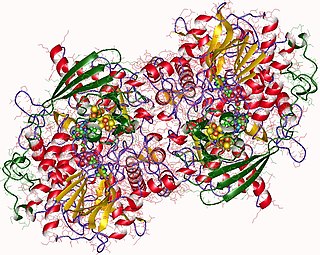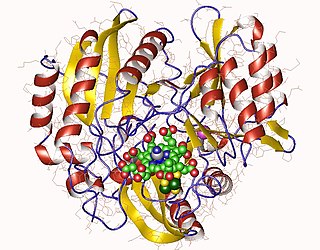Microbial metabolism is the means by which a microbe obtains the energy and nutrients it needs to live and reproduce. Microbes use many different types of metabolic strategies and species can often be differentiated from each other based on metabolic characteristics. The specific metabolic properties of a microbe are the major factors in determining that microbe's ecological niche, and often allow for that microbe to be useful in industrial processes or responsible for biogeochemical cycles.

In enzymology, a sulfite dehydrogenase (EC 1.8.2.1) is an enzyme that catalyzes the chemical reaction
In enzymology, a 4-sulfobenzoate 3,4-dioxygenase (EC 1.14.12.8) is an enzyme that catalyzes the chemical reaction
In enzymology, a benzoate 1,2-dioxygenase (EC 1.14.12.10) is an enzyme that catalyzes the chemical reaction
In enzymology, a biphenyl 2,3-dioxygenase (EC 1.14.12.18) is an enzyme that catalyzes the chemical reaction
In enzymology, a cyclopentanone monooxygenase (EC 1.14.13.16) is an enzyme that catalyzes the chemical reaction
In enzymology, a naphthalene 1,2-dioxygenase (EC 1.14.12.12) is an enzyme that catalyzes the chemical reaction
In enzymology, a phthalate 4,5-dioxygenase (EC 1.14.12.7) is an enzyme that catalyzes the chemical reaction
In enzymology, a proline 3-hydroxylase (EC 1.14.11.28) is an enzyme that catalyzes the chemical reaction
In enzymology, a terephthalate 1,2-dioxygenase (EC 1.14.12.15) is an enzyme that catalyzes the chemical reaction
In enzymology, a cysteamine dioxygenase (EC 1.13.11.19) is an enzyme that catalyzes the chemical reaction

Adenylyl-sulfate reductase is an enzyme that catalyzes the chemical reaction of the reduction of adenylyl-sulfate/adenosine-5'-phosphosulfate (APS) to sulfite through the use of an electron donor cofactor. The products of the reaction are AMP and sulfite, as well as an oxidized electron donor cofactor.
In enzymology, a hydrogensulfite reductase (EC 1.8.99.3) is an enzyme that catalyzes the chemical reaction
In enzymology, a nitroalkane oxidase (EC 1.7.3.1) is an enzyme that catalyzes the chemical reaction

Sulfite reductases (EC 1.8.99.1) are enzymes that participate in sulfur metabolism. They catalyze the reduction of sulfite to hydrogen sulfide and water. Electrons for the reaction are provided by a dissociable molecule of either NADPH, bound flavins, or ferredoxins.

Sulfite reductase (NADPH) (EC 1.8.1.2, sulfite (reduced nicotinamide adenine dinucleotide phosphate) reductase, NADPH-sulfite reductase, NADPH-dependent sulfite reductase, H2S-NADP oxidoreductase, sulfite reductase (NADPH2)) is an enzyme with systematic name hydrogen-sulfide:NADP+ oxidoreductase. This enzyme catalises the following chemical reaction
Sulfur is metabolized by all organisms, from bacteria and archaea to plants and animals. Sulfur can have an oxidation state from -2 to +6 and is reduced or oxidized by a diverse range of organisms. The element is present in proteins, sulfate esters of polysaccharides, steroids, phenols, and sulfur-containing coenzymes.
Sulfur dioxygenase (EC 1.13.11.18, sulfur oxygenase, sulfur:oxygen oxidoreductase) is an enzyme with systematic name S-sulfanylglutathione:oxygen oxidoreductase. This enzyme catalyses the following chemical reaction

Microbial oxidation of sulfur is the oxidation of sulfur by microorganisms to build their structural components. The oxidation of inorganic compounds is the strategy primarily used by chemolithotrophic microorganisms to obtain energy to survive, grow and reproduce. Some inorganic forms of reduced sulfur, mainly sulfide (H2S/HS−) and elemental sulfur (S0), can be oxidized by chemolithotrophic sulfur-oxidizing prokaryotes, usually coupled to the reduction of oxygen (O2) or nitrate (NO3−). Anaerobic sulfur oxidizers include photolithoautotrophs that obtain their energy from sunlight, hydrogen from sulfide, and carbon from carbon dioxide (CO2).
Dissimilatory sulfite reductase is an enzyme that participates in sulfur metabolism in dissimilatory sulfate reduction.






